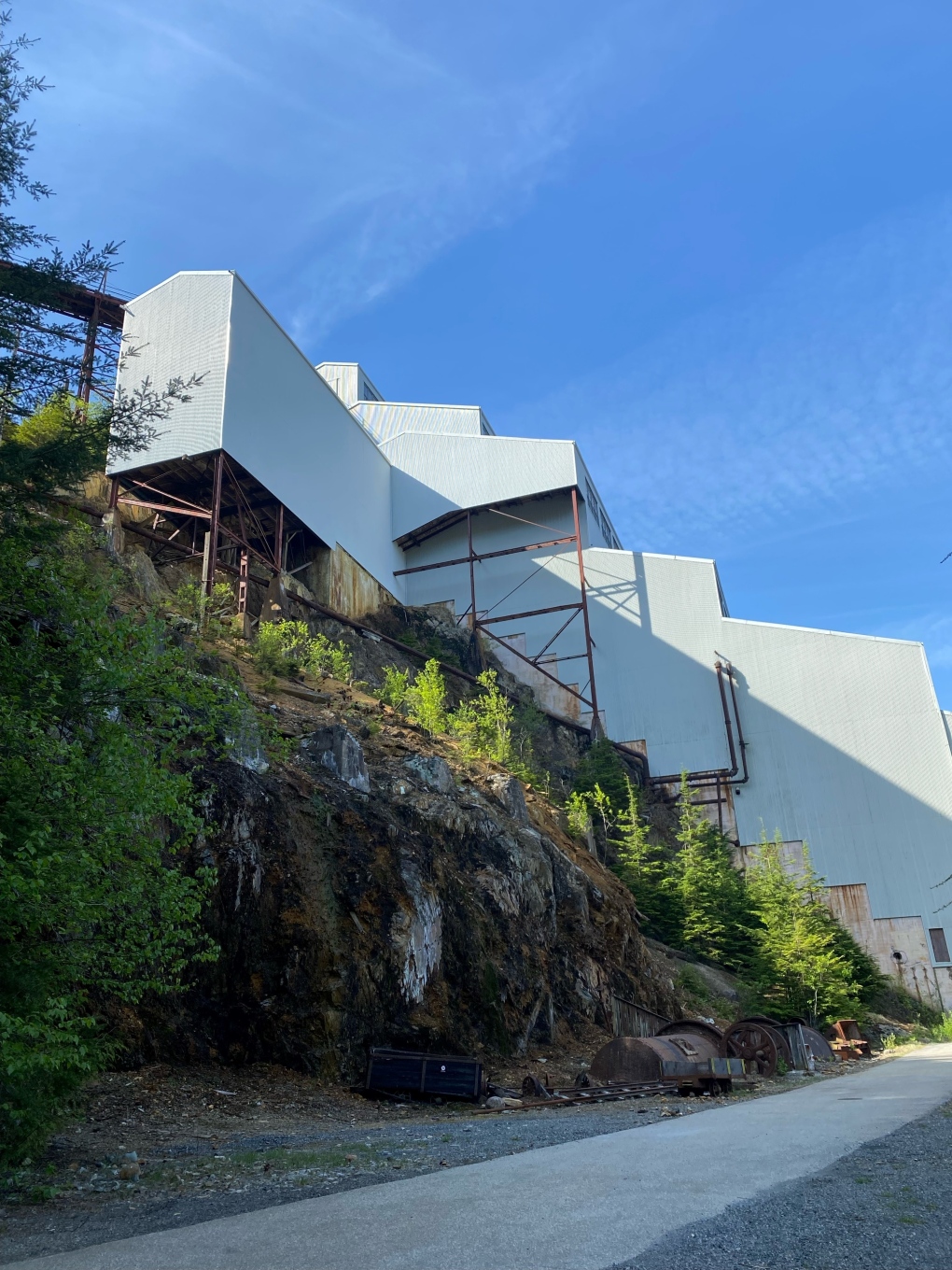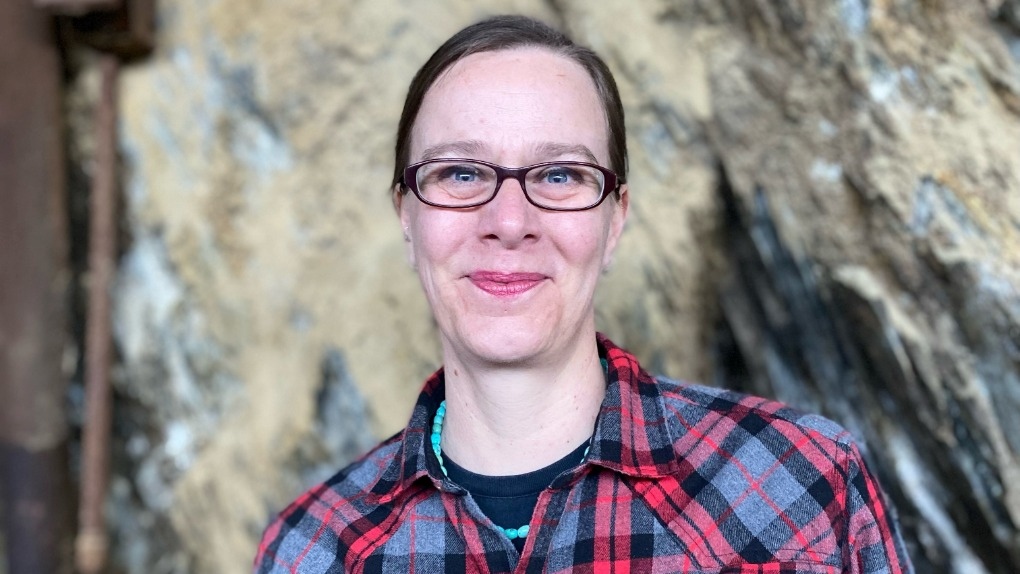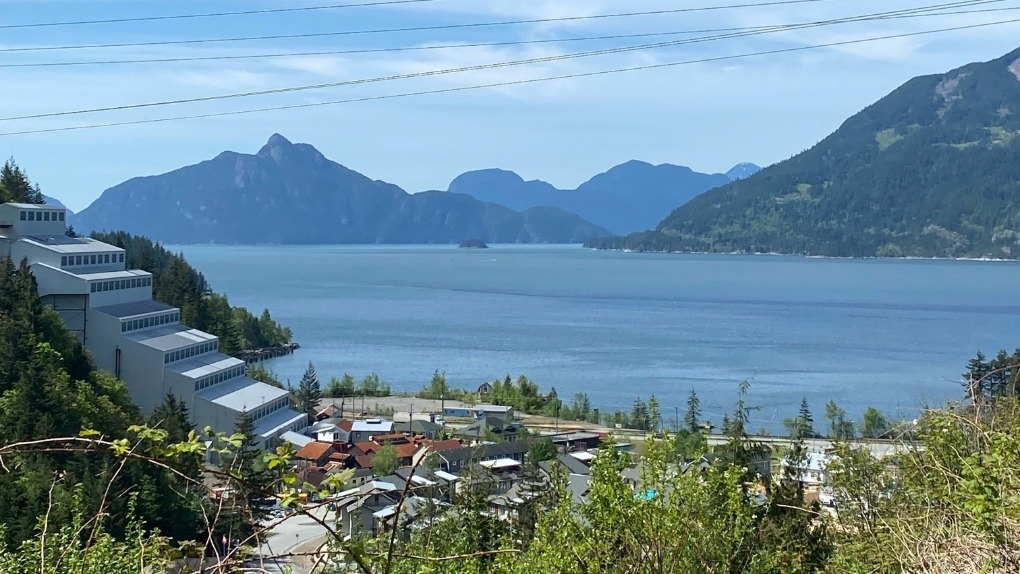
'Cybersecurity incident' shuts down London Drugs stores across Western Canada
All 79 locations of pharmacy and retail chain London Drugs were shut down Sunday after it was the victim of a “cybersecurity incident.”
Off British Columbia's busy Sea-to-Sky Highway just north of Vancouver, is the Britannia Mine Museum, which is now commemorating 100 years of Mill No.3.
 The historic Mill No.3 towers above B.C.'s picturesque Howe Sound. (Melanie Nagy, CTV News)The towering structure, built from concrete and steel in 1923, sits on a mountainside slope next to Howe Sound. Britannia Mine Museum curator Laura Minta Holland says it is not only a provincial landmark, but a place steeped in history.
The historic Mill No.3 towers above B.C.'s picturesque Howe Sound. (Melanie Nagy, CTV News)The towering structure, built from concrete and steel in 1923, sits on a mountainside slope next to Howe Sound. Britannia Mine Museum curator Laura Minta Holland says it is not only a provincial landmark, but a place steeped in history.
"It’s just so impressive when you walk in and it just prompts you to try to imagine what it would have been like when it was a working and operational mill building." Minta Holland told CTV News. "I really feel it has that sense of a cathedral almost, and sometimes we refer to it as a kind of cathedral of engineering."
 Laura Minta Holland, Britannia Mine Museum Curator, shares 100 years of history while inside Mill No. 3. (Melanie Nagy, CTV News)Minta Holland and her team have been working for months on a special celebration to mark the mill's centennial—an exhibit chronicling its lifespan and contribution to mining in Canada is set to open in late May.
Laura Minta Holland, Britannia Mine Museum Curator, shares 100 years of history while inside Mill No. 3. (Melanie Nagy, CTV News)Minta Holland and her team have been working for months on a special celebration to mark the mill's centennial—an exhibit chronicling its lifespan and contribution to mining in Canada is set to open in late May.
"The 20-storey building was constructed by the Britannia Mining and Smelting Company, and took 18 months, from start to finish to complete." said Minta Holland.
 Mill No. 3 towers above the community of Britannia Beach in this undated photo. (Britannia Mine Museum)While the Britannia Mine was in use following the turn of the century, Mill No.3 only became operational after another ore processing structure burned down in 1921. It is now one of the last remaining gravity-fed concentrator mills in North America.
Mill No. 3 towers above the community of Britannia Beach in this undated photo. (Britannia Mine Museum)While the Britannia Mine was in use following the turn of the century, Mill No.3 only became operational after another ore processing structure burned down in 1921. It is now one of the last remaining gravity-fed concentrator mills in North America.
"When we say gravity concentrator, what that means is rather than moving ore up, they were always bringing ore down through the building, which was a process that took less energy and was quite cutting edge at the time."
Copper was the predominant mineral sought, but zinc, lead, silver and gold were also dug out by miners working at Mount Sheer, which was nearby. Once ore was removed, it was transported by train to the top of Mill No. 3 where it underwent it an extensive processing procedure.
Minta Holland describes the process as innovative because not only was ore "crushed by numerous giant ball mills," it was ground into a powder and run through separation machines to prepare it for shipment at a smelter for additional refining.
"The company invested in the technology of the time to make the business more profitable. It was a massive operation that employed thousands of people over the lifespan of the mill," Minta Holland said.
 An undated photo of miners at the Britannia Mines. (Britannia Mines Museum) Along with Mill No.3, there were two towns established by the mining company. The communities, only accessible by boat until the railway and highway were built, were where the miners, mill workers and their families lived.
An undated photo of miners at the Britannia Mines. (Britannia Mines Museum) Along with Mill No.3, there were two towns established by the mining company. The communities, only accessible by boat until the railway and highway were built, were where the miners, mill workers and their families lived.
"It was a wonderful place where nobody locked their doors and everyone knew one another," 85-year old Frances McKilligan told CTV News during a recent visit to the area.
 Frances McKilligan visits the Britannia Mine Museum which is a place directly linked to her family's history. (Melanie Nagy, CTV News)McKilligan's father, who immigrated to Canada after the First World War, worked as a foreman at the site. As for her mother, she was a cook tasked with feeding hungry, hardworking crews before and after their shift. It was a time when both the mill and mine were thriving.
Frances McKilligan visits the Britannia Mine Museum which is a place directly linked to her family's history. (Melanie Nagy, CTV News)McKilligan's father, who immigrated to Canada after the First World War, worked as a foreman at the site. As for her mother, she was a cook tasked with feeding hungry, hardworking crews before and after their shift. It was a time when both the mill and mine were thriving.
"I was born steps away from Mill No. 3 in 1938, and while some people may think it rather strange to grow up there, for me, it was amazing," McKilligan said.
Despite the isolated location, the 85-year old described life outside the mill as "never dull" because there were so many amenities available.
"There was everything to do," she explained. "There was (a) gymnasium, swimming pools, badminton, tennis, theaters and so much more."
Just like the mining company invested in technology, it also invested in the two town sites. In addition to numerous recreation facilities, there were stores, schools and medical centres.
"The mining company supplied everything, people lived well and the community was very close-knit."
 A miner works at the Britannia Mines in this undated photo. (Britannia Mines Museum)McKilligan lived near the mill until 1955, moving away only after she lost both her parents to cancer within a year of each other.
A miner works at the Britannia Mines in this undated photo. (Britannia Mines Museum)McKilligan lived near the mill until 1955, moving away only after she lost both her parents to cancer within a year of each other.
"I have so many happy memories there with my parents," she said. “I shall never, ever forget my upbringing near Mill No.3."
Over the years, 60,000 people from more than 50 different countries, worked and lived in the communities nestled next to the mill. Together, they helped transform it and the mine into one of the world's largest copper production sites.
However, the boom would not last, and after years of dwindling revenue, operations were shutdown in 1974.
"It's still standing today," said Minta Holland. "So it really is a testament to the ingenuity of the people of that time."
 The historic Mill No.3 towers above B.C.'s picturesque Howe Sound. (Melanie Nagy, CTV News)In 1987, 13 years after it closed, Mill No.3 was designated as a National Historic Site.
The historic Mill No.3 towers above B.C.'s picturesque Howe Sound. (Melanie Nagy, CTV News)In 1987, 13 years after it closed, Mill No.3 was designated as a National Historic Site.
Since then, it has been restored and converted into an interactive museum, offering visitors a window into the world of Canada's mining history and into the lives of the people who made the site successful.
"When you come here it is a real opportunity to touch history, quite literally, by walking in and around Mill No.3, which stands here now as a massive inspiration and a true link to our rich, diverse history."

All 79 locations of pharmacy and retail chain London Drugs were shut down Sunday after it was the victim of a “cybersecurity incident.”
Three women diagnosed with HIV after getting 'vampire facial' procedures at an unlicensed medical spa are believed to be the first documented cases of people contracting the virus through a cosmetic procedure using needles.
Elias Lindholm scored 1:02 into overtime and the Vancouver Canucks came all the way back to beat the Nashville Predators 4-3 in Game 4 of their first-round playoff series on Sunday.
One person was killed in a six-vehicle crash on Highway 400 in Innisfil Friday evening.
Aerial photos posted by Chinese state media on Sunday showed wide devastation in part of the southern city of Guangzhou after a tornado swept through the day before, killing five people, injuring dozens others and damaging more than 140 buildings.
Ontario is introducing a suite of measures that will crack down on cellphone use and vaping in schools.
Australia's Prime Minister Anthony Albanese on Monday described domestic violence as a 'national crisis' after thousands rallied around the country against violence toward women.
Rookie goalie Arturs Silovs will start in net for the Vancouver Canucks when they face the Nashville Predators in Game 4 of their first-round playoff series Sunday.
U.S. intelligence officials have determined that Russian President Vladimir Putin likely didn't order the death of imprisoned opposition leader Alexei Navalny in February, according to an official familiar with the determination.

The lawyer for a residential school survivor leading a proposed class-action defamation lawsuit against the Catholic Church over residential schools says the court action is a last resort.
Raneem, 10, lives with a neurological condition and liver disease and needs Cholbam, a medication, for a longer and healthier life.
As if a 4-0 Edmonton Oilers lead in Game 1 of their playoff series with the Los Angeles Kings wasn't good enough, what was announced at Rogers Place during the next TV timeout nearly blew the roof off the downtown arena.
Mounties in Nanaimo, B.C., say two late-night revellers are lucky their allegedly drunken antics weren't reported to police after security cameras captured the men trying to steal a heavy sign from a downtown business.
A property tax bill is perplexing a small townhouse community in Fergus, Ont.
When identical twin sisters Kim and Michelle Krezonoski were invited to compete against some of the world’s most elite female runners at last week’s Boston Marathon, they were in disbelief.
The giant stone statues guarding the Lions Gate Bridge have been dressed in custom Vancouver Canucks jerseys as the NHL playoffs get underway.
A local Oilers fan is hoping to see his team cut through the postseason, so he can cut his hair.
A family from Laval, Que. is looking for answers... and their father's body. He died on vacation in Cuba and authorities sent someone else's body back to Canada.